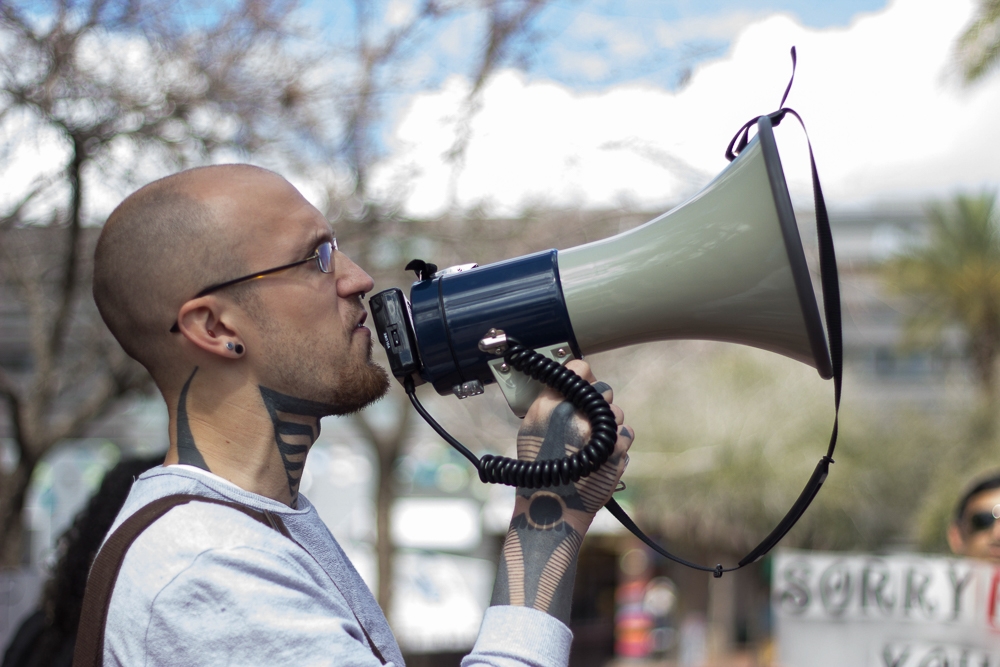In case you missed it, the country will soon be voting for who should hold the office of U.S. President. If you want to figure out what the issues facing the U.S. are, where you stand on them and what you can do about it, take a look at this guide.
This is a simplified, loose but effective list of steps assembled to help you blaze your own trail for becoming a politically informed and active young adult. These steps are not necessarily in chronological order or are definitive commandments. If you feel a step is missing to this list or that you wish to comment, let us know.
Step 1: Find out what you believe in

Photo by Gretchen Burnton | The State Press
Instead of vaguely complaining about the political systems and the many many problems you may believe there are, take a minute to focus that passion and desire for change and construct a few questions to ask yourself. What do I believe in? What is fair? What is not fair? What needs to change? What could be improved?
Answering these questions can help you form a clearer picture of your political ideologies. One easier way of doing this is taking a political compass test. This test will ask you basic, easy-to-understand questions about political issues. After the test is concluded, your answers are processed through an algorithm and your political compass is plotted (see below). Answer these questions honestly, as they are for your own benefit.
Read more: Rally encourages students to raise voices, cast vote
Step 2: Inform yourself about the issues you care about
Photo by Johanna Huckeba | The State Press
Now that you have a rough idea of what you believe in, inform yourself about the political issues you have interest in. Taking 15-30 minutes a day to brush up on the day's happenings and/or updates on political issues that interest you is a huge benefit.
By informing yourself in one way or another, you can help establish a worldview and allow yourself to see the structure and action on the chaotic blue dot you share with others.
Here are several outlets you can check out, sorted by the political leanings of their average reader:
Right-leaning: FOXNews.com, Breitbart, Drudge Report
(Nearly) Center: RealClearPolitics, FactCheck.org, The Wall Street Journal, Bloomberg
Left-leaning: The New York Times, MSNBC, The Guardian
Reporter's note: No single news source will give one a clear, unbiased worldview. One can only achieve that through reading content from both sides of the political aisle and by constructing one's own opinion.
Read more: ASU College Republicans member sends letter to Democratic legislative members
Step 3: Find a group that believes what you believe

Photo by Beth Easterbrook | The State Press
This is where it gets fun. Use this step to challenge your beliefs by exposing yourself to others' different perspectives. ASU has 20 registered political student organizations. Once you find a group that shares the same beliefs as you, it will give you opportunities to meet new people and discuss issues in an open environment. However, never only surround yourself with people who agree with you, always maintain your skepticism and make an effort to keep an open mind.
Read more: ASU Black and African Coalition, student government fight blackface
Step 4: Find a candidate that believes what you believe

Photo by Ben Moffat | The State Press
Next, you should begin researching candidates who most align with your worldview and want to change the things you want to see changed. If you are trying to decide who to vote for in the presidential election, you should evaluate your prospective candidates thoroughly.
Here is a rough guide to doing that:
- Take a quiz to find out which candidate best represents you
- Find out where candidates stand on the issues you care about and check their voting history
- Read about your candidates in media
- Take your time to decide which candidate has your support
This thinking process can be applied to local government officials as well.
Read more: 2016 Republican candidates: white llamas or black llamas?
Step 5: Get Involved

Photo by Ben Moffat | The State Press
By now you should feel something, an urge to want to change something or have your concerns heard. Getting involved could not be easier. Voter turnout of the voting age population in the 2012 election was 54.9 percent. That's low. Expecting political change to happen and not voting is like wanting to get in shape and not exercising and dieting. Don't know how to register to vote? Reporter Aimee Plante made a guide for you.
Candidates for local and national offices will welcome campaign volunteers with open arms. If you feel as if political change is worth spending a fraction of your free time, contact your candidate's campaign office or meet with student groups on campus who share your goals. If you cannot find a group that suits your needs, you can always make one.
Read more: Future of marijuana in Arizona could depend on voters
Reach the reporter at anicla@asu.edu or follow @AndrewNiclaASU on Twitter.
Like The State Press on Facebook and follow @statepress on Twitter.





